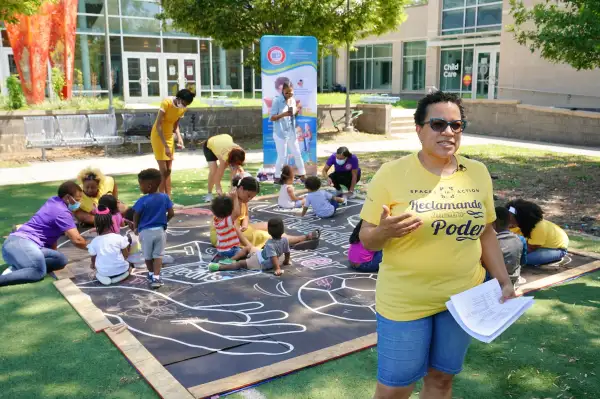Child Tax Credit Payments Have Failed to Reach Many Vulnerable Families. Can Local Campaigns and PTA Moms Fix That?

At a daycare center in Washington, D.C., dozens of children spent a sunny July afternoon drawing with sidewalk chalk. It was, for the most part, a typical summer scene. But unlike the usual rainbow free-for-all you might expect from toddlers and elementary schoolers, these kids were on a mission: raising awareness about the new child tax credit.
The chalk art was part of an ongoing project to let low-income parents know that they might be eligible for the new monthly payment program, which provides families with deposits totaling hundreds of dollars a month.
The payments, part of a temporary expansion of the child tax credit, started in July. But many lower-income families still don’t know about them or have had trouble signing up. The chalking event is just the latest in a series of campaigns that D.C.-based nonprofit organization SPACES in Action has launched to get families enrolled.
“Our hope is that by having their babies be the messengers, we’ll be able to get the [information] to their parents,” says LaDon Love, the executive director of SPACES in Action, which advocates for marginalized families.
Hailed as the government’s “biggest anti-poverty program” in decades, the expanded child tax credit gives parents earning less than $150,000 a year up to $300 a month per child. It also delivers half of the amount of the credit via monthly payments during the second half of the year. The credit is fully refundable this year, too, so even poorer families who don’t owe taxes can access the full amount.
Some experts have estimated that the monthly payments could help lift millions of children out of poverty, potentially cutting the poverty rate by as much as half. Yet that goal may be in danger, advocates say, due to the number of hoops that the poorest parents must jump through to actually get the money.
So even though the first of the payments has already gone out, advocates and community leaders are busier than ever. Local and national organizations like SPACES in Action are still pounding the pavement, both literally and figuratively, to sign families up.
“We want to make sure folks are getting their money that they are due,” Love says. “This tax credit belongs to the families that are raising their children.”
Overcoming hurdles to enroll in monthly payments
It was always going to be a big task for the IRS to roll out a large payment plan on a short timeline. The law overhauling the child tax credit was passed in March, giving the agency just four months to design a monthly payment program that could reach up to 96% of U.S. households while also juggling tax season and stimulus checks.
The IRS decided to handle the rollout much like it did stimulus checks. Payments to most parents would be automatic. But the agency would have to collect income or bank information for some 7 million families who are eligible but earn too little to be required to file taxes. Those families would have to enroll in the program using a tool dubbed the “Non-Filer Sign-up Tool.”
If you don't know about the tool, finding it isn't always straightforward. For one, Democratic leadership has been encouraging Americans to visit childtaxcredit.gov to learn more. Following that link takes you to an official White House website page, but that’s not actually where the tool lives. Users instead have to navigate through another three separate web pages before they land on the actual sign-up tool.
But critics have noted that even upon reaching the tool, it’s only available in English, making it difficult to navigate for approximately 67 million families who speak another language at home (though a 21-page guide for enrolling is available in Spanish). The non-filer website is also not designed for mobile users, another hurdle for the growing number of low-income families who rely solely on a smartphone for internet access. According to the Pew Research Center, 26% of Americans earning less than $30,000 have a smartphone but no broadband internet access at home.
The agency hasn’t released information on how many families have received the first monthly payment from the child tax credit. But data from the distribution of stimulus checks may give a hint. As the Washington Post recently reported, only 720,000 — around 10% — of the poorest families successfully enrolled in stimulus payments using the same type of non-filer sign up tool. A recent report from the Center on Budget and Policy Priorities estimated some 4 million children may still be missing out on payments.
Love, with SPACES in Action, has had the unique experience over the past few months of both fighting on Capitol Hill for more accessibility options for parents using the portal and doing on-the-ground work to get families signed up. She has seen firsthand just how many concerns linger for families who qualify but worry about the potential consequences if they enroll.
“There are a lot of folks who are concerned because maybe they owe taxes and they’re fearful of what that means if they file,” she says. (Concerned parents should note that the IRS is not legally allowed to take away your child tax credit payments to pay off any federal debts you owe, including taxes.)
Some parents she’s spoken to are afraid, based on their previous experiences with the U.S. welfare system, that they will lose other necessary benefits like Medicaid or SNAP if they get too much money from the advanced payments. SPACES in Action is stressing to families that that’s not the case; the child tax credit doesn’t count toward peoples’ income.
For Love, getting the child tax credit into the hands of as many parents as possible is personal.
“There was a time when I was a single mom trying to navigate these systems and I didn't always know exactly where to go,” she says.
Making complicated tax law understandable
One of the challenges for groups like SPACES in Action is striking the right balance between making information about the child tax credit easy to understand while still covering all the nuances of a fairly complicated tax credit. That’s where Timothy Flacke comes in.
Flacke is the executive director and co-founder of Commonwealth, a nonprofit focused on helping low-income Americans become financially secure. The group has been tapping into its network of commercial and non-profit financial advisors, tax preparers and social service organizations to educate them on how to have conversations with families that can clearly and accurately convey how the monthly payments could help their finances in the long term.
“If you're holding down multiple jobs and trying to raise kids, you're probably not spending all your free time reading up on the nuances of federal policy,” Flacke says. “That's just not realistic, most of us can't do that.”
Commonwealth created the website TaxTimeHub.org to give companies and organizations messaging tools designed after conducting research on the types of messages that resonate most with low-income households.
On its face, the credit sounds simple enough: It gives up to $3,600 for each child under 6 and up to $2,000 for older children, with half of that amount distributed in monthly installments. But rarely is the tax code so straightforward.
For example, some parents who receive the monthly payments now could end up owing money when they file their taxes in the spring. That might happen to parents who have wages primarily from tips or contract work who don’t get taxed accurately throughout the year.
This issue is exactly why Flacke says his team ultimately had to scrap a strategic messaging idea that said ‘This money doesn’t have to be repaid,’ despite the phrase initially testing well.
“It’s more complicated when you have to say ‘This is great news, except for the 2% of you for whom it’s not,’” Flacke says.
Child tax credit advice from one parent to another
It’s not just a poor program roll out or a complicated benefit that’s jeopardizing whether some parents will be able to take advantage of the money. Rebecca Garcia, president of the Nevada Parent-Teacher Association, attributes some of the confusion to simple information overload.
There have been so many different programs rolled out over the past year, from enhanced unemployment to changes in welfare benefits to stimulus checks, that she says “Parents are just like, ‘I can’t do one more thing.’”
Garcia helps run a 14,000-member Facebook group for the parents of Clark County School District — the fifth-largest district in the nation — that has become something of a go-to child tax credit resource for families in Las Vegas and the surrounding areas.
“There’s been a lot of questions about logistics,” she says. “Trying to figure out how these benefits work can be very challenging.”
The Facebook group, whose membership has doubled since the start of the pandemic, has transformed from a basic message board for relaying announcements from the school district into a community where parents turn to for answers on anything related to their children’s wellbeing. Discussions have ranged from how-to guides for putting together a virtual classroom space to daily updates on every food distribution site in Las Vegas.
But recently, the questions have revolved mostly around the child tax credit: What should I do if I just had a baby? (You can’t yet report that to the IRS, but you will get the full credit for your new baby.) What if I just got divorced? (The parent who provides for the child for more than half the year gets the money.) What if we didn’t file last year? (You’ll have to use the Non-Filer Tool that has frustrated so many.)
Garcia and her fellow Facebook group leaders aren’t tax policy experts, but that’s what she thinks makes them effective messengers.
“There's a higher trust level with fellow parents than typical media resources,” Garcia says. “It's just that feeling of ‘I want somebody to give me information on how they've done it.’”
As a parent herself, Garcia knows just how vital this money can be to families in need. She is also a mother, on top of being a community leader. She works part-time so that she could spend more time at home with her four children, three of whom are still under 18. While she considers her family to be middle class, a recent back surgery without any paid time off, plus a broken-down car have made money tighter than usual — so the first child tax credit payment couldn’t have come at a better time.
“Being the one who’s managed my family’s budget for years, there’s a lot of stress,” Garcia says.
In the past, Garcia says her family has had to put expenses on their credit card during the year and then use their tax refund to finally pay it off. From her perspective, one benefit of the monthly payments is the ability to not only pay off debt, but to stay out of it entirely.
She could be onto something: around 40% of Americans could not cover an unexpected $400 expense without carrying a balance on their credit card, according to the Federal Reserve. It’s a problem that could be alleviated by having a cash injection of up to $300 per child each month.
“There are so many families who don’t have a lot of extra money, especially not for surprise bills,” she says. “There’s potential now for people to have those expenses paid for in cash and not have to go into debt.”
More from Money:
The Best Ways to Spend Your Child Tax Credit Money, According to Experts
Here's Where You Can Buy School Supplies (and More) Without Paying Sales Tax This Month

